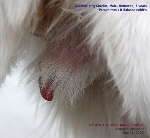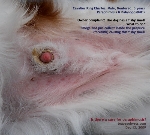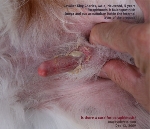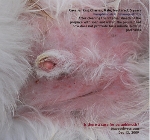Paraphimosis - protrusion of the penis with an inability to retract the penis into the prepuce.
|
Causes: 1. Idiopathic - No known causes 2. Small preputial orifice 3. Weakened preputial muscles 4. Trauma 5. Shorter prepuce Possible medical conditions 1. Posthitis - Inflammation of the prepuce. 2. Phalitis - Inflammation of the penis. 3. Balanitis - Inflammation of the head of the penis (glans penis). 4. Balanoposthitis - Inflammation of the head of the penis and the internal layer of the prepuce. Treatment: 1. Surgery to prevent balanoposthitis in this case. Which surgical approach? How many approaches are there? 2. Medical treatment. Retract prepuce to the level of the bulbus glandis and wash it with soap and water every day. 3. Others? Can you think of any? |
 |
 |
|
 |
 |
|
 |
 |
|
|
What is the best surgical approach? To just enlarge the preputial orifice or make a longer incision to the level of the bulbus glandis as drawn in my surgery plan? |
||
Dec 16, 2009.
The case is being reviewed for
the next 2 weeks as the dog is
given medication.
The small preputial orifice got
swollen 6 weeks after the first
treatment. This could be due to
the dog's lifestyle - humping on
cushion though he is neutered at
2 years of age (belated) and
sunbathing for 15-20 minutes a
day nowadays.
When the inflammation is gone,
surgery may be the only option
as daily pulling back of the
internal layer of the prepuce to
wash away the smega and pus may
be too much work for the young
working lady owner.
Presently, the lady is cleaning
the glans penis after the dog
pees. The dog may wait for the
lady to come home from work
before peeing. During the first
treatment, he had no problem
peeing. But at other times, he
seemed to take a long time
before he could pee. "This means
he has had pain in his penis," I
said. "So, he could not pee
easily unlike after his first
treatment in October."
So, what to do now?
"This is not a common surgery,"
I inform the young couple. It is
not like sterilisation of the
dog. So, the outcome is not so
well known. There is
circumcision surgery in human
males but is this the approach
for paraphimosis in the dog?
 TOA
PAYOH VETS
TOA
PAYOH VETS